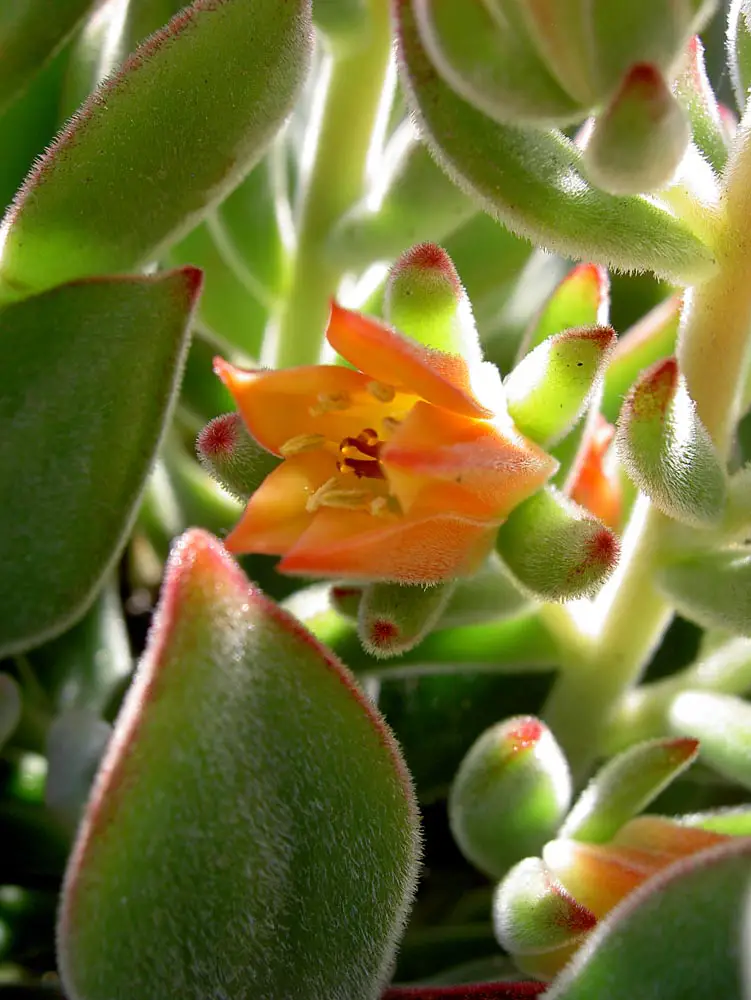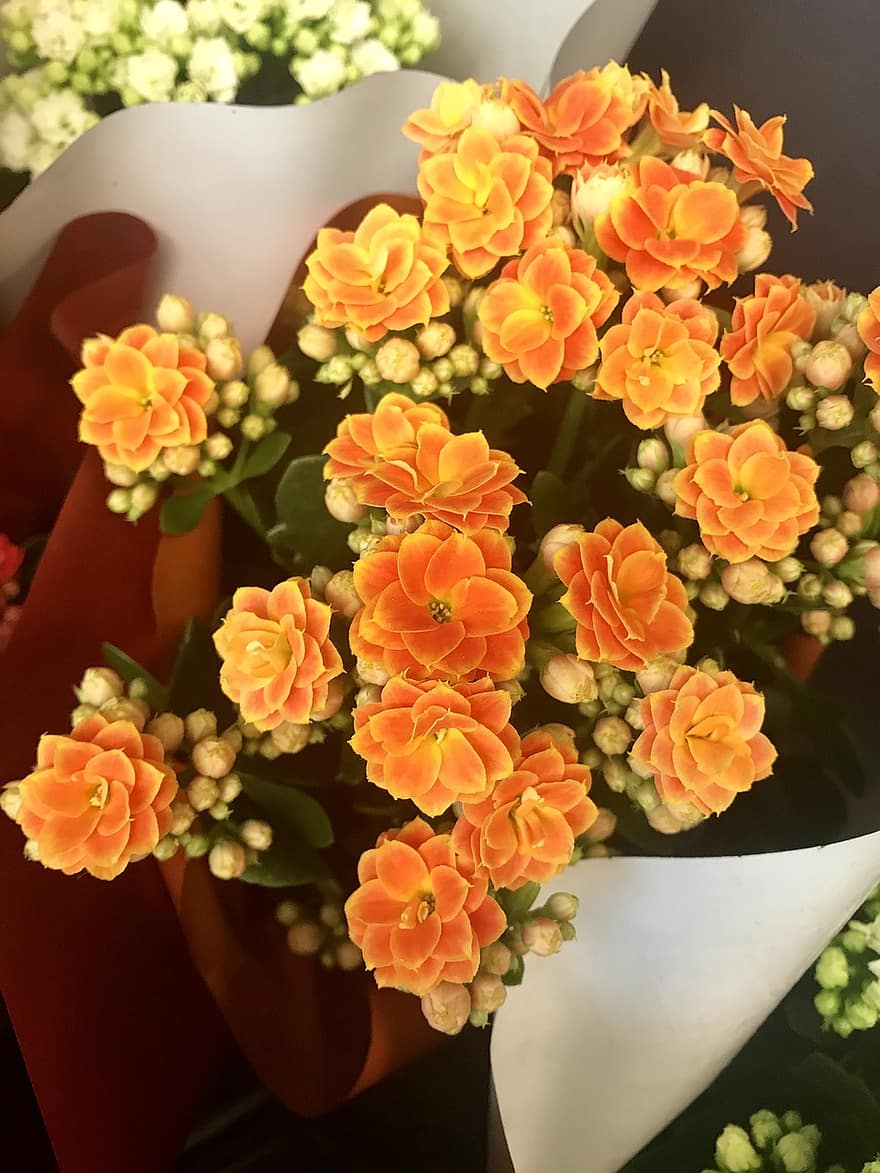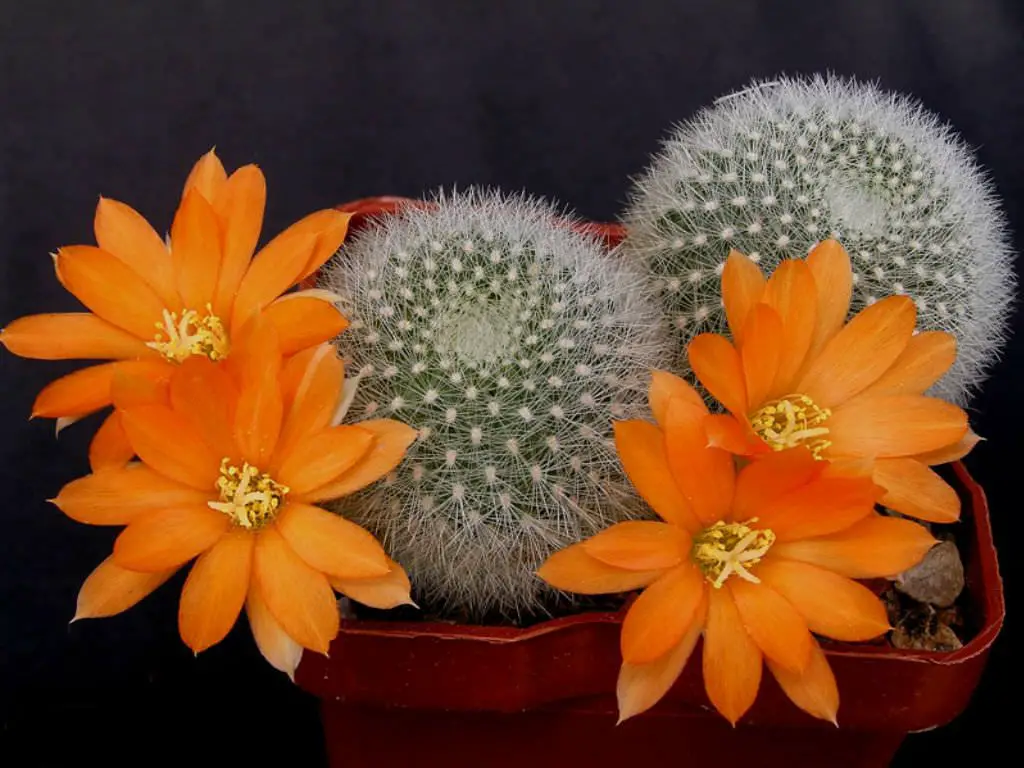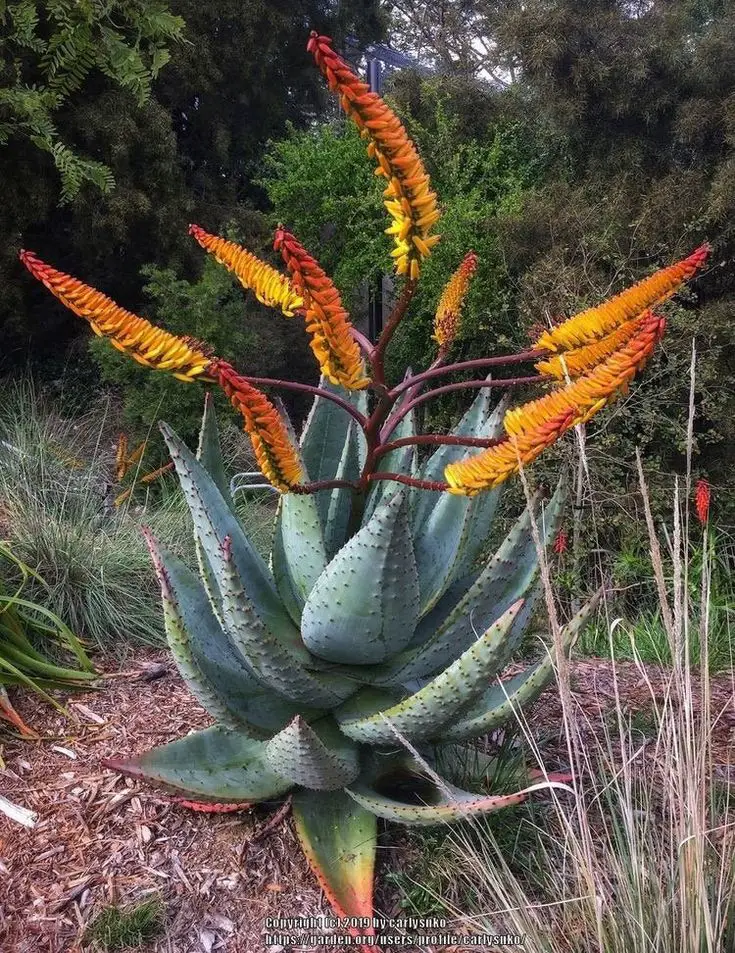I got up one fine morning and found myself embezzled by the warm and fuzzy feeling. Could not find what was the actual reason for the feeling and my better half showed me the exact cause that gave that unique feel as soon as I opened my eyes. There were succulents blooming with the orange flowers just in front of eyes and there were what resulted in a very decent and enjoyable feeling.
It may be a great scene to witneess the succulents flowering, but then the succulents with Orange flowers have been one of the decent options that can be quite soothing to the eyes and mid alike. We decided to go on a ride to find the best succulents with orange flowers.In fact, Succulents with orange flowers are an impeccable combo of warmt and brilliance.
Here are 10+ Succulents with orange flowers that are very aesthetic and enticing. These forgetful succulents won’t allow you to forget them and you will love to have them around. Let’s explore…
Echinopsis Chamaecereus – Peanut Cactus
TheEchinopsis Chamaecereus is native to Bolivia and Argentina. The plant can grow to six meters wide and six meters tall. They have peanut shaped stems and that is exactly why they are called Peanut cactus.
- Cylindrical, finger like stems
- Large orange red blooms
- Low growing, creeping
- Shallow roots
Description
A native to Argentina, Echinopsis chamaecereus, the Peanut cactus is a low- growing succulent that can be about 15cm (6 inches) tall and 12 inches wide when mature. Peanut cactus has many soft, cylindrical, finger or long peanut like stems that are pale green in colour and appear crawling on the pot.
In Spring and Summer, this ornate cactus produces funnel shaped, bright orange flowers that are much larger in contrast to the size of the plant.
It is a clumping and fast growing cactus with shallow roots.
Caring Tips
This cactus cannot endure a hard frost, but in freezing temperatures, keep them indoors near a sunny window sill or under a grow light. Bright sunlight, proper drainage and sporadic watering is all they need to prevent rot.
Use containers with many drainage holes. Water adequately to run out of the drainage holes and then wait till the soil is dry fully before watering again.
Well-draining cactus and succulent soil with 50% to 70% mineral grit like coarse sand, perlite or pumice is highly recommended.
This plant can be easily propagated by stem cuttings.
- Bloom Time: Spring and Summer
- Geographical Location: Argentina
- Sun Exposure: Full Sun
- Plant Zone: 10-11
Begonia Boliviensis Bonfire
- Tuberous, saw-toothed foliage with red margins
- Bell-shaped, bright orange flowers
- Avoid low temperatures and high humidity to prevent Powdery mildew infestation
Description
Begonia boliviensis Bonfire has tuberous, saw-toothed foliage with red margins that bloom with bright-orange, bell-shaped flowers covering the plant from late spring to summer.
Plants can be 2 feet tall and like sunny locations. Plants have longer stems and fewer flowers in shaded areas.
Bonfire can be grown in pots, in hanging baskets, and as landscape plants.
Caring Tips
These plants grow well in a well-draining, organic medium. They can be easily propagated from cuttings. Begonias require a minimum of 12- 14 hours of sunlight to initiate flowering. Overwatering should be avoided to prevent root rot or leaf drop and provide good air circulation around the plants. Powdery mildew can occur in low temperatures and high humidity. Keep the area well-ventilated to avoid disease problems. Common insect problems include snails, slugs, aphids, whitefly, and sciarid fly.
Echeveria pulv-Oliver
- Hairy, light green leaves with red tips
- Orange flowers
- Commonly known as Red Echeveria
Description
Echeveria ‘Pulv-Oliver’ is a graceful succulent with hairy, light green leaves with red tips grouped near the ends of the branches and can be up to 1 foot (30 cm) tall.
Flowers bloom in late spring and summer and are orange and Echeveria pulv-Oliver in full bloom is very magnificent.
Caring Tips
Water your Pulv- Oliver just like any other succulent, but it should not be allowed to sit on the water.
Soak & dry method is best to water this succulent plant and avoid over-watering as it can kill the plant.
It prefers full sun and can be grown outdoors.
It can be propagated by leaves, cuttings, or seeds.
Kalanchoe Blossfeldiana (Flowering Kalanchoe)
- Thick scalloped leaves
- Bunches of flowers in red, yellow, pink and bright orange color
- Can bloom up to 6 months in favorable conditions
Description
A native to Madagascar, Kalanchoe Blossfeldiana, commonly known as a flowering Kalanchoe, is a flowering plant with thick, scalloped leaves producing bunches of flowers in various colors such as red, yellow, pink, and bright orange blooms from mid-January to June.
This succulent grows 6 to 12 inches tall and needs sunlight and sporadic watering to stay alive. Each flower has four petals that grow at the top of thin green stems. Keep it on a sunny spot on the windowsill to enjoy these lovely flowers.
How to Induce Bud Development in Kalanchoe Blossfeldiana Succulents?
As the flowers of Kalanchoe begin to die, cut them to remove these drying blooms to prevent the plant from using energy in trying to sustain an already used part.
During summers, keep the plant in a sunny location in well-draining soil and maintain an optimum level of moisture.
As fall arrives, cut back on the watering and keep your Kalanchoe indoors. Keep it in low light conditions from fall to late winter, which initiates the first buds formation. This will enhance and improve plant health, Kalanchoe flowering.
If you need blooms at a specific time like Christmas, minimize watering and keep the plant in a dark room for a 14-hour period daily 6 weeks before the desired bloom time.
Instead of the room, you can keep the plant in a closet or under a box for 14 hours and give 10 hours of bright light.
Keep the plant warm away from cool air. Stop watering or feeding the plant for 6 weeks.
As you see flower buds, place the plant in brighter light and resume watering. In spring, feed the plant and remove old flowers to stimulate new buds.
These plants are easy to grow with low maintenance and bloom up to 6 months with beautiful, little flowers.
Caring Tips
Kalanchoe plants flourish in well-draining, cacti or succulent mix and should be placed in bright, indirect light.
Overwatering can be harmful for Kalanchoe survival. Allow the soil to dry completely before watering.
Cleistocactus Icosagonus
- Tall columnar cactus with shiny golden spines
- Bright orange-red blooms
Description
Cleistocactus is a tall, columnar cactus with shiny golden spines. Cleistocactus can reach heights of 60 centimeters (up to 2 feet) and diameters upto 5 inches. Cleistocactus icosagonus produces unique, orange tubular flowers in favorable conditions. This cactus produces berries.
Caring Tips
They prefer sunny areas and dry soil. Sandy soil or gritty-sandy soil is best for the plants. It can withstand temperatures down to -7°C.
Water like any other succulent and avoid over-watering.
Desert Gem (Opuntia rufida)
- A small Prickly pear cactus with dwarf pads
- vibrant orange blooms.
Description
Desert Gem is a small variety of prickly pear cactus with dwarf pads and vibrant orange blooms. It can grow 6 to 12 inches (15 to 30 cm.) tall. It is a drought-tolerant succulent and a good choice for xeriscaping.
Caring Tips
Water regularly just like any other succulent and avoid overwatering. Desert Gem likes to be in the Full Sun. It can be easily propagated from woody stem cuttings. Allow the cut surface to callus before planting.
Lobivia Jajoiana ( Echinopsis Jajoiana)
- Accepted Scientific Name: Echinopsis jajoina
- The throat ring of the flower is very dark purple-violet to black.
- Variable flower colors like yellow, vine red, violet, and orange
- Crown of the cactus has a wooly texture
Description
Echinopsis jajoiana is a cactus with orange flowers on top. The flower color of Echinopsis jajoiana is variable like vine red, violet, yellow and orange, all having in common that the throat ring of the flower called hymen is always bright, very dark purple-violet to black with thickened edges and have yellow anthers and purple stamens.
The stem is flat, grey-green, globose, or egg-shaped and elongates as it grows older and 50 to 60 mm. in diameter. The crown of the plant is slightly drooping with a white, wool-like texture.
Lobivia blooms with attractive flowers from basal tubercles located on the top of the plant. The petals of the flowers can be about 7 cm wide in colors like yellow, red, violet and orange.
Caring Tips
This succulent needs lots of fresh air and bright sunlight. In summers, water jajoiana regularly. This plant can endure varied temperatures of the daytime heat and nighttime cold. It can survive frost well by just keeping it dry.
Orange Snowball (Rebutia muscula)
- Fuzzy succulent with orange flowers
- Small pale green stems with wooly white spines
- Bright orange-red blooms
Description
Rebutia Muscula or Orange Snowball is a fuzzy succulent with orange flowers.
Rebutia is a small individual or clustering cactus with pale green stems covered in dense wooly white spines, initially hemispherical and grows elongated later.
Wooly white spines protect it from extreme cold and scorching sunlight.
It grows closer to the ground spreading up to 6 inches (15 cm) and produces offsets with age. The stems are about 1.6 inches (4 cm) in diameter, normally taller than broad.
Orange Snowball is a popular, easy-to-grow cactus with bright orange- red blooms from April to June.
Caring Tips
During the growing season (spring and summer), the potting soil should dry out completely between waterings, then water thoroughly. Limit watering in winters. Fast-draining, rich cactus mix is best for this cactus.
Aloe Ferox
- Commonly known as bitter aloe, Cape aloe, Tap aloe, Red aloe
- Yields non bitter gel used in cosmetics
- Large, bright orange or red flowers
Description
Aloe ferox is a flowering woody aloe plant indigenous to southern Africa. It is one of the various Aloe species used to make bitter aloes, a laxative medication, and yields a non-bitter gel used in cosmetics.
Aloe ferox is a tall, single-stemmed aloe with thick, fleshy leaves with reddish brown spines on edges and smaller spines on the upper and lower surfaces, arranged in a rosette.
The stem grows upto 10 feet (3.0 m) in height. Younger plants have leaf surfaces covered in spines, but as they mature and get taller, the leaves start losing most of their spines except for those along the margins.
However in some areas, they retain most of their spines.
It produces large, bright and orange or red flowers standing in multi- branched inflorescence, about 2 to 4 feet above the leaves.
Aloe ferox plants are propagated mainly from seed and head cuttings.
Caring Tips
Aloe ferox is happy in open areas in dry-tropical climates with full sun. Well- draining, sandy-loamy soil with good drainage is best for this plant.
Watering adequately and let the soil dry between waterings.
Aloe Marlothii( Mountain Aloe)
- A large evergreen succulent plant
- Also known as Mountain Aloe or Flat, flowered Aloe
- Bright red, yellow, or orange-red inflorescence
Description
A native to Botswana, Mozambique, Swaziland, South Africa, and Zimbabwe, Aloe Marlothii is a large, evergreen succulent plant about 8 to 10 feet tall, also known as flat flowered Aloe.
It has thick greyish-green leaves tapering from a broad base to a sharper point forming a dense rosette and growing up to 5 feet long.
Old leaves remain draped from the stem forming a skirt or petticoat adding to the robust appearance of this plant.
The withered skirt and well-spread rosette give this plant a well-rounded appearance, even at full height.
Initially, the reddish-brown spines on this plant are densely present even on the lower surfaces of leaves but thin out with age.
Spines are also present on the margins of each leaf, appearing randomly across the fleshy parts.
Flowers bloom in late fall to early winter and form a panicle containing about 30 racemes which grow mostly horizontal.
The inflorescence of Aloe marlothii is a strikingly bright red, yellow or orange-red in color.
The plant attracts both songbirds and hummingbirds, thus adding to its beauty.
Caring Tips
This plant likes to be in the full sun. It can withstand temperatures as low as 15° degrees F (-9° C).
While first planting or transplanting Aloe marlothii, water the plant once in a week for the first month, then wean off later. A well-established mountain aloe can survive without water for several months.
In summers, water Aloe marlothii frequently and in winter avoid watering it or water less frequently.
Aloe marlothii can thrive in a wide range of soil types, sand or loam and acidic, alkaline, and neutral pH soils.
If the leaves are excessively inflated, it is a sign of overwatering, which can lead to rot if not addressed timely. Dull, thin leaves are a sign of dehydration.
Echeveria Doris Taylor
- Succulent with orange flowers on long stems
- Also known as a wooly rose plant
- Fancy orange flowers
Description
Echeveria ‘Doris Taylor is a succulent with orange flowers on long stems and is also known as the woolly rose plant.
Doris Taylor is a fascinating, pale green succulent plant with dark leaf tips and fuzzy leaves.
It has a beautiful rosette shape growing 7 to 8 inches (18-20 cm.) around and 3 to 5 inches (7.6-13 cm.) tall.
Fancy, orange blooms appear on 8- to 10-inch (20-25 cm.) long stems on the plant in late spring and summer.
This succulent is amazing not only because of its fuzzy rosette but also due to its unique flowers.
Trim stems once flowering is finished.
Caring Tips
Wooly Rose needs little water. While growing Wooly rose indoors, place it near a window where it gets full morning sun or bright light for a longer time period.
Outdoors, filtered sunlight can be given, but this plant shows best growth and blooming when a few hours daily of direct sun is provided.
Slowly acclimatize your plant to a full sun situation.
During the hottest days of summer, keep Doris Taylor in shade in the afternoon.
Water moderately during the growing season; Water even lesser in winters, when the plant is dormant.
A mix of half potting soil and half coarse sand is best for Doris Taylor succulent plant.
Water should quickly drain past the roots and exit the container.
Fertilize your plant in spring and summer with diluted cactus and succulent food for better growth.
Dark leaf tips appear due to sunlight and low water conditions.
Crown cactus
- Spreads to a height of 15 cm.
- white, short, silky spines
- Require a very moderate watering
- Small and best suited as an indoor plant[/su-list]
Description
This is again cactus that is native to Bolivia. The flowers are orange and red.. They resemble small crowns and hence they are named as Crown Cactus. The perennial cactus grows to only upto a smaller height. Since the cactus is covered wiht sharp spines, they should better be kept out of the reach of children. The cactus has also won the award for the Royal Horticultural Society’s Award of Garden Merit.
Caring Tips
They ae quite low on maintenance and do not need to any special care as such. They can be kept in the direct sunlight and can also withstand a decent amount of shades. Make sure that you are watering it quite moderately. The soil should dry out completely between the two watering sessions.
Well, those were just a few of the best succulents with orange flowers. Of course, you may not be able to find all of them a practical solution to pick for your individual garden, but can pick a feew of them based on your preferecnes and the size of your garden. The tips and cre required for each of the cacti above should help you arrive at the best possible experience in enjoying the best flowering options ever.





